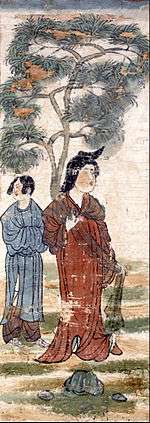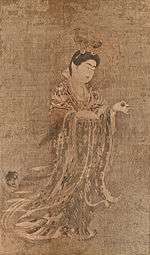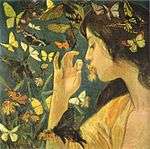Reminiscence of the Tempyō Era
Reminiscence of the Tempyō Era (天平の面影, Tempyō no omokage) is a 1902 painting by yōga artist Fujishima Takeji (1867–1943). Inspired by nostalgia for the Tempyō era[1] and, like his Butterflies and covers for the literary magazine Myōjō, an influential exemplar of Meiji romanticism, it has been designated an Important Cultural Property.[2][3][4] It is part of the collection of the Ishibashi Foundation.[2]
.jpg)
Description
Fujishima Takeji combines Japanese elements, such as the tall vertical format of a hanging scroll, the gold background, and the timeless subject of a sinuous beauty beneath a tree, with a classicizing horizontal band, a low wall with a sculpted frieze in relief, all executed in the western-derived medium of oil upon canvas. Beneath the angled branches of the vertical paulownia, the figure—according to one theory, the Empress Kōmyō herself[5]—stands barefooted, her weight on her right leg. Wearing a high striped skirt, her hair is bound high in a double top-knot, in the manner of noble ladies of the period known as ni-kei (二髻) or sō-kei (双髻).[5][6] She holds an ornately lacquered sixteen string kugo, modelled on one in the Shōsōin.[7][8] A contemporary review in the Miyako Shimbun highlights the air of mystery and imagination that accompanies her seemingly calm poise.[9] Art historian Harada Minoru writes of how, in this work, as in Butterflies, the artist "has gone beyond the plein-air style that dominated his early paintings to create his own unique expression through delicacy of line and brushstroke, imaginative composition, and brilliant colour".[4]
Background
In the words of Ernest Fenollosa, "we can know the material side of Tempyo [minutely] through the Shosoin Museum".[10] After the 1878 gift to the Imperial Household of 319 treasures from Hōryū-ji, to be placed at the new precursor to the Tokyo National Museum, and the early Meiji inventories of the Shōsōin, study and appreciation of early Japanese art grew apace, as reflected in the early moves for the preservation of cultural properties that culminated in the 1897 Ancient Temples and Shrines Preservation Law, supplementary provisions to which extended protection to treasures in their charge.[11][12]
History
Part of the contemporary so-called "Tempyō boom" (「天平ブーム」),[8] the artist's sketchbooks from this period include reworkings of the celebrated painted panels from a byōbu in the Shōsōin depicting a beauty under a tree, as well as of a lacquered kugo from the same repository of treasures; as in the 1895 replica, the original instrument instead features twenty-three strings. Other sketches include figures in long striped skirts, based on the Nara-period Illustrated Sutra of Cause and Effect, and studies of contemporary female hairstyles based on paintings and statues, such as that of the National Treasure Kichijōten at Yakushi-ji.[3][8][13]
The painting was first exhibited at the Seventh Hakuba-kai ("White Horse Society") Exhibition, held in September and October 1902 in Ueno Park, in one of the halls from the 1877 inaugural National Industrial Exhibition. There it appeared under the name Reminiscences of the Tempyō Period (天平時代の面影).[3] Subsequently, acquired by the Ishibashi Foundation, it was displayed at the Ishibashi Museum of Art, now the Kurume City Art Museum in Kurume, Fukuoka Prefecture, before being transferred to Tokyo with the 2016 changes to the museum's management and ownership. Stored at the Ishibashi Foundation Art Research Center, it will be periodically displayed at the related Artizon Museum (formerly the Bridgestone Museum of Art).[2][14][15]
The painting inspired a poem by Kambara Ariake that opens: "What dost thou search, a thousand years or dust, fair maiden?"[4] It also exerted a strong influence over the romanticist Aoki Shigeru.[2] More recently, the painting, alongside Aoki Shigeru's 1904 A Good Catch or Harvest of the Sea, has provided the inspiration for composer Hirano Ichirō's (平野一郎) nineteen-minute Umi no Sachi / Tempyô no Omokage~Diptych for Soprano & Piano: after Kambara Ariake’s Poetry.[16]
Gallery of related works
 Beauty beneath a Tree (Tang dynasty), said to have been excavated from Turfan (MOA Museum of Art)
Beauty beneath a Tree (Tang dynasty), said to have been excavated from Turfan (MOA Museum of Art) Lady under a Tree, from a byōbu now separated into its six panels, one bearing the date Tenpyō-shōhō 4 (752) (Shōsō-in)
Lady under a Tree, from a byōbu now separated into its six panels, one bearing the date Tenpyō-shōhō 4 (752) (Shōsō-in).jpg) Lady under a Tree from Fujishima Takeji's sketchbooks
Lady under a Tree from Fujishima Takeji's sketchbooks Lady under a Tree, from a byōbu now separated into its six panels, one bearing the date Tenpyō-shōhō 4 (752) (Shōsō-in)
Lady under a Tree, from a byōbu now separated into its six panels, one bearing the date Tenpyō-shōhō 4 (752) (Shōsō-in)2.jpg) Lady under a Tree from Fujishima Takeji's sketchbooks
Lady under a Tree from Fujishima Takeji's sketchbooks_(14586247020).jpg) Treasures of the Shōsō-in, including the kugo
Treasures of the Shōsō-in, including the kugo.jpg) Kugo from Fujishima Takeji's sketchbooks
Kugo from Fujishima Takeji's sketchbooks2.jpg) Kugo from Fujishima Takeji's sketchbooks
Kugo from Fujishima Takeji's sketchbooks3.jpg) Kugo from Fujishima Takeji's sketchbooks
Kugo from Fujishima Takeji's sketchbooks
.jpg) Kichijōten from Fujishima Takeji's sketchbooks
Kichijōten from Fujishima Takeji's sketchbooks.jpg) Illustrated Sutra of Cause and Effect (ICP) (Nara period) (Nara National Museum)
Illustrated Sutra of Cause and Effect (ICP) (Nara period) (Nara National Museum).jpg) Illustrated Sutra of Cause and Effect from Fujishima Takeji's sketchbooks
Illustrated Sutra of Cause and Effect from Fujishima Takeji's sketchbooks.jpg) Preparatory Tobira-e, Kaidan-in, Tōdai-ji (ICP) (Kamakura period)
Preparatory Tobira-e, Kaidan-in, Tōdai-ji (ICP) (Kamakura period).jpg) Tobira-e, Kaidan-in, Tōdai-ji from Fujishima Takeji's sketchbooks
Tobira-e, Kaidan-in, Tōdai-ji from Fujishima Takeji's sketchbooks
 Enjoyment (1904) by Aoki Shigeru (Ōhara Museum of Art)
Enjoyment (1904) by Aoki Shigeru (Ōhara Museum of Art) Sotoori-hime (1905) by Wada Eisaku (Kabuki-za)
Sotoori-hime (1905) by Wada Eisaku (Kabuki-za).jpg) Kaguya-hime (1909) by Mitsutani Kunishirō (Kasama Nichidō Museum of Art)
Kaguya-hime (1909) by Mitsutani Kunishirō (Kasama Nichidō Museum of Art).jpg) Standing Women (1924) by Kikuchi Keigetsu (Nagano Prefectural Shinano Art Museum)
Standing Women (1924) by Kikuchi Keigetsu (Nagano Prefectural Shinano Art Museum).jpg) Field Entertainment (1925) by Wada Eisaku (University Art Museum, Tokyo University of the Arts)
Field Entertainment (1925) by Wada Eisaku (University Art Museum, Tokyo University of the Arts).jpg)
 Harvest of the Sea (ICP) (1904) by Aoki Shigeru (Ishibashi Foundation Art Research Center)
Harvest of the Sea (ICP) (1904) by Aoki Shigeru (Ishibashi Foundation Art Research Center) Butterflies (1904) by Fujishima Takeji (private collection)
Butterflies (1904) by Fujishima Takeji (private collection) Cover for Myōjō by Fujishima Takeji, February 1901 edition
Cover for Myōjō by Fujishima Takeji, February 1901 edition Cover for Myōjō by Fujishima Takeji, February 1904 edition
Cover for Myōjō by Fujishima Takeji, February 1904 edition
See also
| Wikimedia Commons has media related to Takeji Fujishima. |
References
- "Reminiscence of the Tempyo Era". Ishibashi Museum of Art. Retrieved 16 September 2015.
- 天平の面影〈藤島武二筆/油絵 麻布〉 [Reminiscence of the Tempyo Era, oil on canvas, by Fujishima Takeji] (in Japanese). Agency for Cultural Affairs. Retrieved 12 July 2020.
- Ueno Kenzō 植野健造 (1996). 白馬会と歴史主題の絵画 藤島武二《天平の面影》をめぐって [The White Horse Society (Hakubakai) and Historical Painting: Fujishima Takeji's Tempyō no omokage]. Bijutsu-shi (in Japanese and English). The Japan Art History Society. 45 (2): 207–24.
- Harada Minoru 原田実 (1974). Meiji Western Painting. Weatherhill. pp. 91–2, 96, 100.
- 藤島武二「天平の面影」に描かれた女性の髪型の名称を知りたい [I should like to know the name of the female hairstyle of Fujishima Takeji's "Reminiscence of the Tempyo Era"] (in Japanese). National Diet Library. 4 May 2016. Retrieved 12 July 2020.
- Na-Young Choi (2006). "Symbolism of Hairstyles in Korea and Japan". Asian Folklore Studies (PDF). Nanzan Institute for Religion and Culture. 65: 69–86.
- 漆槽箜篌(正倉院模造) [Lacquered Kugo (replica of the Shōsōin instrument)] (in Japanese). Tokyo National Museum. Retrieved 16 September 2015.
- Hirade Minori 平出美乃里 (March 2019). 藤島武二「天平の面影」に見る箜篌について [About the Kugo seen in Fujishima Takeji's "Reminiscence of the Tempyo Era"]. 文化財学報 (Bulletin of the Study of Cultural Properties) (in Japanese). Nara University (37): (15)–(26).
- 白馬会関係新聞記事 第7回白馬会展 都新聞 1902-10-06 [Newspaper Articles Relating to the Hakuba-kai: Seventh Hakuba-kai Exhibition (Miyako Shimbun 6 October 1902)] (in Japanese). Tobunken. Retrieved 16 July 2020.
- Fenollosa, Ernest (1912). Epochs of Chinese and Japanese Art: An Outline History of East Asiatic Design. William Heinemann. p. 155.
- McDermott, Hiroko T. (2006). "The Hōryūji Treasures and Early Meiji Cultural Policy". Monumenta Nipponica. Sophia University. 61 (3): 339–374. JSTOR 25066447.
- Satō Dōshin 佐藤道信 (2011). Modern Japanese Art and the Meiji State: The Politics of Beauty. Getty Research Institute. pp. 53 ff. ISBN 978-1606060599.
- Iwao Seiichi; et al., eds. (1992). Dictionnaire historique du Japon. XVIII (Lettre S). Kinokuniya. p. 102.
- 天平の面影〈藤島武二筆/油絵 麻布〉 [Reminiscence of the Tempyo Era, oil on canvas, by Fujishima Takeji] (in Japanese). Agency for Cultural Affairs. Retrieved 16 September 2015.
- Satō Dōshin 佐藤道信 (2014). 圖版 藤島武二 天平の面影 [Reminiscence of the Tempyo Era, by Fujishima Takeji]. Kokka (in Japanese with English summary). Asahi Shimbun Publications. 1425: 46–8.CS1 maint: unrecognized language (link)
- 日本の作曲家の作品 2013〜2014 [Works by Japanese Composers 2013–2014] (PDF) (in Japanese). Suntory. p. 29. Retrieved 13 July 2020.